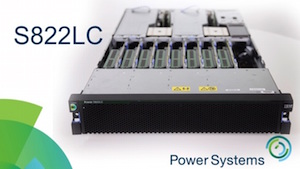IBM’s New Open Linux Power Servers Take on x86 in HPC

(Source: IBM)
With today's release of three Linux-based, open architecture Power processor servers, IBM hopes to take away market share from the x86 servers many enterprises currently use for high performance computing, big data, and cloud.
Enterprises are willing to switch processor allegiance if the results pay off, wrote the Linley Group in a June 2015 report, "A Guide to Server Processors."
"Performance per watt and performance per watt per dollar are the new metrics driving purchasing decisions in large datacenters. Physical density is also growing in importance, driving greater scalability and new systems such as microservers that pack more nodes into precious rack space," the research firm said. "Although software compatibility remains important, datacenter customers are more willing than before to adopt new platforms if the cost savings and performance are compelling."
IBM anticipates its new Power Systems LC servers – based on technologies and development initiatives from OpenPOWER Foundation partners such as Canonical, Mellanox, Nvidia, Tyan, and Wistron – will entice organizations to switch to its open architecture. OpenPOWER's more than 150 members build solutions atop IBM's Power processor, using an open and collaborative approach designed to accelerate innovation and development. And when it comes to software, there are more than 1,900 apps available on Linux and the Power line, Sumit Gupta, vice president, HPC and OpenPOWER Operations at IBM, told EnterpriseTech.
"This is not a next generation of an existing lineup. This is a brand new addition to the product line," he said.
Expected to ship later this year, the Power Systems LC line comes in three flavors:
- The Power Systems S812LC is a 1-socket 2U system, featuring up to 10 cores, 1 terabyte of memory, 115 gigabytes per second of memory bandwidth, and up to 14 disk drives. IBM designed this server for workloads that are memory- and storage-intensive, including Spark, Hadoop, and big data. Online pricing starts at $6,595.
- The Power Systems S822LC for commercial computing is a 2-socket 2U system that includes up to 20 cores, 1 terabyte of memory, and 230GB/second memory bandwidth. Online pricing starts at $11,990.
- When enterprises have high performance computing in mind, the S822LC HPC server features two integrated Nvidia Tesla K80 GPU accelerators, and delivers more than 2x performance per core, 40 percent improved price performance, and better than 2X memory bandwidth with fully configured memory than a similarly configured x86-based E5-2699 version 3, according to IBM. Online pricing was unavailable; enterprises should contact IBM for costs.
Although this is not IBM's first foray into Linux, the LC family marks the developer's first direct volley against Intel's high-end servers, a fast-growing area driven by HPC, cloud, big data, and Internet of Things.
"We've had a Linux offering in the past … but LC brings down the price point and the performance point so we can go after the entire x86 market and can have higher performance," said Gupta. "We are trying to give clients the high performance they need that is not met by the current infrastructure they have."
In addition to selling systems through business partners, IBM also offers enterprises the option of buying online, simply by clicking a button on its website.
"You start with the workloads, then you start with how does that client purchase systems today," Gupta said. "The market is such that every major systems manufacturer has an online presence. It enables clients to configure systems online. This is a new trend for Power Systems."
Another new trend for IBM: Its adoption and promotion of cognitive systems. Unveiled this week at the Gartner Symposium/ITXPO in Orlando, the initiative revolves around enterprises' expanding data – and their need to make sense of it all, said Doug Balog, general manager of IBM Power Systems in a statement.
Allegiant Air has been using Linux on Power Systems to immediately analyze customer behavior on its website, allowing the low-cost airline carrier to quickly adjust prices when it spots trends such as price-sensitivity, according to IBM.
"All enterprises are facing growing amounts of data," said Brian O’Neil, director of Data Architecture at Allegiant Travel, in a release. "It’s how you analyze – and what you do with – the results that allows you take the lead. Leveraging Linux on IBM Power Systems, we have been able to immediately glean valuable insights from a number of data sources, enabling us to take action quicker and more efficiently than ever before."
Related
Managing editor of Enterprise Technology. I've been covering tech and business for many years, for publications such as InformationWeek, Baseline Magazine, and Florida Today. A native Brit and longtime Yankees fan, I live with my husband, daughter, and two cats on the Space Coast in Florida.











